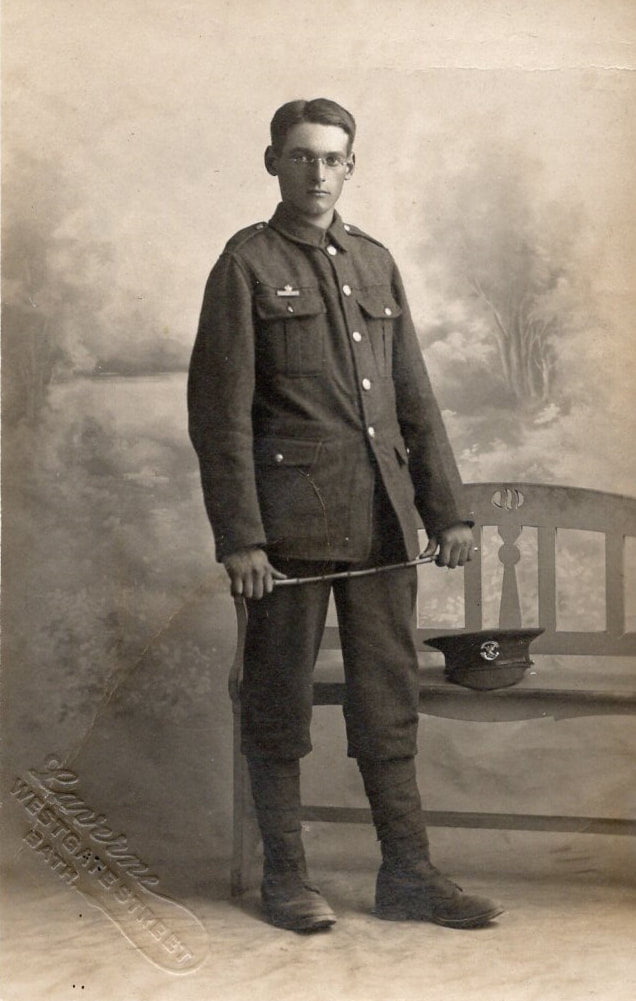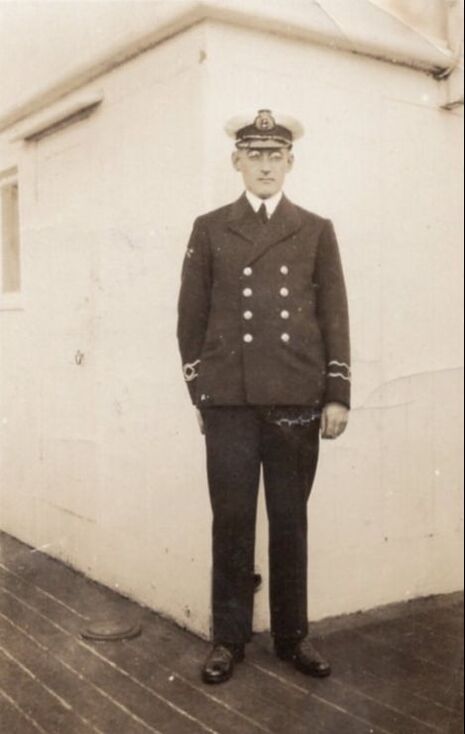Arthur Brooke Memories James Browning Recounted in March 2018
Jim Browning recalled the man who lived at 2 Mead Villas:
Arthur Brooke went into the Merchant Navy then became prominent in local Toc H. He was very good at telling stories and I remember staying with him in a bell tent with the Scouts in Devon when he spent a lot of time reciting naval memories.
Arthur Brooke went into the Merchant Navy then became prominent in local Toc H. He was very good at telling stories and I remember staying with him in a bell tent with the Scouts in Devon when he spent a lot of time reciting naval memories.
Left: Arthur Brooke in about 1915 before he was posted abroad and Right: in the inter-war years (courtesy John Brooke Flashman)
Toc H was a Christian Society for ex-servicemen founded after the First World War. Its name was derived from the signals spelling alphabet used in the Great War meaning T which stood for the name of one of the founders, Neville Talbot. It became an international organisation aiming to bring social integration for disadvantaged sections of society. Sometimes its work was through simple acts of kindness, offered to people of all classes (it adopted the concept of Everyman, through four fundamental ideas: friendship, service, fairmindedness and the Kingdom of God). A good example of its work was the organisation’s 1930 commitment to the British Empire Leprosy Association.
We will never know why Arthur was attracted to the Toc H organisation. There was a huge upsurge in the amount of vagrancy in the inter-war years, often comprised of servicemen with physical or mental disabilities who found it difficult to settle back into their pre-war lives and employment. They would often wander around the country, sleeping rough or in deserted buildings or outhouses. The Vagrancy Act of 1824 allowed the police to arrest homeless soldiers after the Napoleonic Wars (an act still in existence and use), which was opposed by the Toc H organisation.
Many workhouses and hospitals set up casual wards offering a night’s shelter to those in desperate need, estimated at one point to be 30,000 people.[1] George Orwell described the inhumane conditions offered to vagrants in a workhouse refuge in 1931 called The Spike: The doors were locked on the outside a little before seven in the evening and would stay locked for the next twelve hours.[2]
We will never know why Arthur was attracted to the Toc H organisation. There was a huge upsurge in the amount of vagrancy in the inter-war years, often comprised of servicemen with physical or mental disabilities who found it difficult to settle back into their pre-war lives and employment. They would often wander around the country, sleeping rough or in deserted buildings or outhouses. The Vagrancy Act of 1824 allowed the police to arrest homeless soldiers after the Napoleonic Wars (an act still in existence and use), which was opposed by the Toc H organisation.
Many workhouses and hospitals set up casual wards offering a night’s shelter to those in desperate need, estimated at one point to be 30,000 people.[1] George Orwell described the inhumane conditions offered to vagrants in a workhouse refuge in 1931 called The Spike: The doors were locked on the outside a little before seven in the evening and would stay locked for the next twelve hours.[2]
John Brooke Flashman Wrote in April 2022
I can confirm that Arthur was a great raconteur. Once, when staying with us in Gillingham, Dorset, he was invited to spend an evening with the owner of the milling company where my father was employed. It was a warm summer's evening in the early 1950s and we sat outdoors in the mill gardens and spent a wonderful couple of hours hearing all about Arthur's seafaring experiences. What a pity he didn't set it all down on paper.
I didn't know that Arthur was able to venture outdoors unaided after having his leg amputated. I always assumed that he was effectively housebound once he was discharged from hospital. James Browning's recollection in the story of the Davies Family corrects this, saying that Arthur walked from his home to Barn Piece - a walk of about a quarter of a mile, all uphill.
One of the big ironies of Arthur and Gertie's married life was that, once Arthur had retired from the merchant navy, the intention was that he and Gertie would visit some of the exotic places he talked about so much. In the event they managed only one holiday together, in Scotland. Only a few weeks after their return Arthur was driven into Bath by his brother Eric, who dropped him off at an agreed point. A few minutes after Eric had driven off Arthur collapsed on the footway, and was admitted to hospital.
I can confirm that Arthur was a great raconteur. Once, when staying with us in Gillingham, Dorset, he was invited to spend an evening with the owner of the milling company where my father was employed. It was a warm summer's evening in the early 1950s and we sat outdoors in the mill gardens and spent a wonderful couple of hours hearing all about Arthur's seafaring experiences. What a pity he didn't set it all down on paper.
I didn't know that Arthur was able to venture outdoors unaided after having his leg amputated. I always assumed that he was effectively housebound once he was discharged from hospital. James Browning's recollection in the story of the Davies Family corrects this, saying that Arthur walked from his home to Barn Piece - a walk of about a quarter of a mile, all uphill.
One of the big ironies of Arthur and Gertie's married life was that, once Arthur had retired from the merchant navy, the intention was that he and Gertie would visit some of the exotic places he talked about so much. In the event they managed only one holiday together, in Scotland. Only a few weeks after their return Arthur was driven into Bath by his brother Eric, who dropped him off at an agreed point. A few minutes after Eric had driven off Arthur collapsed on the footway, and was admitted to hospital.
References
[1] See the excellent website article Tramps and Vagrants (workhouses.org.uk)
[2] The Spike | The Orwell Foundation
[1] See the excellent website article Tramps and Vagrants (workhouses.org.uk)
[2] The Spike | The Orwell Foundation

